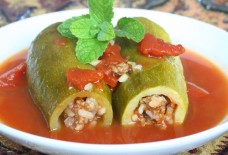15 Arab-Irish Connections You Didn't Know
posted on: Mar 17, 2017
By Albawaba
So what do Brian O’Driscoll and Arifa Bseiso, Dabkeh and The Script, a foamy pint of Guinness and an aromatic Arabic coffee all have in common? A lot more than you might think.
Scientists have proof that Ireland’s present population is founded on a mass migration of Mesopotamian farmers. These Stone Age migrants moved westward from the place where agriculture began carrying their farming intel, and genes for dark eyes and darker hair (red hair DNA sailed in with Viking invasions, thousands of years later.) Is blood really thicker than water? Read on to see how else Ireland and the Arab world link up.
1. Bloodlines
reland’s bloodline traces back 6,000 years to a multicultural swath of Middle East better known as the Fertile Crescent. Anthropological geneticists now say that ancient migrant infiltrations merged with the island’s original peoples, setting the genetic foundation for what would become “the Irish”. Image: Daniel Bradley, Trinity College.
2. Ancestors
Scientific findings conclude that the ancestors of prehistoric Irishmen hailed from the area around contemporary Levant and migrated across the southern Mediterranean, making the modern-day Irish genetic cousins of ethnic Arabs from the Levant. (Image: Daily Mail)
3. Language
The newcomers set the basis of what became the Irish language. Word similarities include butterfly (Arabic: farashah, Irish: féileacán) and sugar (Arabic: sukkar, Irish: siucra). The “Ogham Stone”, a key to Ireland’s earliest form of writing carved onto upright stones, bears parallel inscriptions in Kufic Arabic and Egyptian hieroglyphics.
4. Archeology
Greco-Egyptian astronomer Ptolemy produced maps of Ireland accurate enough to show Lambay Island, a spit of land off the coast of northern County Dublin. Lambay is one of the Irish places where archaeologists found tombs of people buried standing, as is the traditional burial in some parts of the Middle East. (Image: Mabinogion Astronomy)
5. Tombs
Trinity College archeologists unearthed a boy’s skeleton at The Mound of the Hostages, a neolithic passage tomb in County Meath. A necklace found with the skeleton was made of faience beads and matched similar Egyptian manufacture and design. Hard evidence for Egyptians in ancient Ireland, or a bit of the blarney? (Image:www.ancient-origins)
6. Ottoman Empire
In 1847, the peak of the Irish potato famine, an Irish doctor in Istanbul asked Ottoman Sultan Abdülmedjid I to send aid. He obliged, sending three ships of grain to Drogheda port, north of Dublin. The grateful city put the Turkish star and crescent on its crest, where it still remains. It appears too on Drogheda United jerseys. (Image: wikipedia)
7. Palestine
Irish identity is steeped in rebellion against colonialism and occupation. Irish NGOs and government often condemn Israel for its treatment of Palestine. Irish hold clear views on Israel and Palestine and aren’t afraid to vocalize it. Ireland is one of Europe’s fiercest critics of Israel. (Image: Taken in Northern Ireland -Alamy/Guardian)
8. Gaza
During the 2010 Gaza blockade, the Irish ship MV Rachel Corrie joined the Freedom Flotilla to deliver humanitarian aid, such as medical supplies, wheelchairs, and cement. But the ship – carrying human rights activists and journalists – was reportedly sabotaged by IDF along with four other boats and was unable to reach the strip. (Image: Free Gaza)
9. Palestinian Prisoners
This Bobby Sands quote was seen on the Separation Wall in Palestine. Sands was a prominent Irish political prisoner who went on hunger strike before dying in custody in 1981. His story is not unlike the plight of Palestinians in administrative detention in Israel, with the latest high-profile case being that of journalist Muhammad al-Qiq.
10. Lebanon
Irish peacekeeper forces have been present in southern Lebanon since 1978. The Lebanon mission is a source of great pride for Ireland, due to the Irish troops’ success and reputation – and this has left a saga of goodwill and warm relations between both peoples. (Image: Irish Defence Forces)
11. Athletics
The number of Irish expats living in Dubai and Abu Dhabi amounts to over 10,000, a 30% increase in the last ten years. They bring their passion for team sports and socializing, so it’s no surprise that Irish expats in the Gulf are easily found in rugby clubs, Gaelic Athletics Association (GAA) and ladies’ sports teams! (Image: courtesy photo)
12. Customs
Arabs and Irish share many complimentary customs and tribal-based traditions, underpinned by large extended families. Both cultures are famed for friendliness and hospitality (just try declining another cup of tea!). Music and storytelling loom large, and politics and religions mash-up as the preferred debate topic – always. (Image: Irishcentral)
13. National Trauma
Irish and Arabs share national trauma, old and new, with similar resiliency, rebounding from histories of poverty and emigration. The Irish Potato Famine, which started in 1845, killed an estimated 1 million people and drove millions abroad, a pattern of emigration that continues today, mirroring the exodus from Syria and Iraq. (Image: Tumblr)
14. Irish Pubs
If people know anything about the Irish, it is their love of fun and partying in pubs! That’s why their biggest export around the world are traditional Irish pubs, even in the Middle East! Would things have worked out differently for the ME if Lawrence of Arabia had been Irish and not British?
15. Music
What’s a party without music? Both cultures hold fast to their traditional sounds, which also have uncanny parallels: consider the Irish Bodhran vs. Arab Tabla. And don’t get us started on the UAE’s love affair with Guinness World Records, a slideshow in itself. Dubai holds the record for world records, named after Ireland’s iconic brew.








